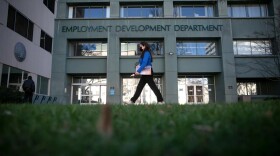California Gov. Gavin Newsom is willing to throw a financial lifeline to the state's major utilities dealing with the results of disastrous wildfires — but only if they agree to concessions including tying executive compensation to safety performance.
A proposal unveiled Friday by Newsom's office aims to stabilize California's investor-owned utilities and protect wildfire victims as the state faces increasingly destructive blazes. Regulators say some previous fires were caused by utility equipment.
Pacific Gas & Electric Corp., the largest of the three investor-owned utilities, filed for bankruptcy in January as it faced tens of billions of dollars in potential costs from blazes, including the November fire that killed 85 people in the Paradise area.
Newsom hopes to strike a deal with lawmakers in just three weeks, but leaders in the Legislature said they haven't been given a formal legislative proposal and would need to go through their normal review process.
"There's a lot of moving parts," Newsom told reporters in San Francisco, adding if lawmakers are "committed to this issue, they'll get it done."
The plan comes as credit ratings agencies look warily upon the utilities.
Southern California Edison and San Diego Gas & Electric had their ratings downgraded earlier this year, and executives have pushed lawmakers to come up with a plan that stabilizes the industry.
RELATED: California Eyes Risk Pool As It Struggles With Costly Fires
Newsom proposal would give Southern California Edison and San Diego Gas & Electric the power to decide which form of financial aid they want, based on whether they're willing to make their shareholders contribute.
They could choose a liquidity fund to tap to quickly pay out wildfire claims or a larger insurance fund that would pay claims directly to people who lose their homes to fire.
The ratings agency Moody's has said creating a sort of insurance or liquidity fund would have a positive impact on the credit of utilities in the state.
The liquidity fund would be about $10.5 billion and paid for by a surcharge on ratepayers, said Ana Matosantos, Newsom's cabinet secretary. If utilities want the larger insurance fund, they'd have to pitch in another $10.5 billion. Both utilities have to agree on which option to choose.
PG&E would not get a say in which fund the state uses or be able to tap a fund until it resolves its claims from the 2017 and 2018 wildfire seasons and emerges from bankruptcy. Its exit plan could not harm ratepayers and it would have to continue the utility's contributions to California's clean energy goals.
Spokespeople from all three utilities said they are reviewing the proposal and did not comment further.
The utilities would have to implement a number of safety measures to tap into the fund, such as tying executive compensation to safety, forming a safety committee within its board of directors and complying with wildfire mitigation plans.
State legislators voted last year to require California's electric companies to adopt those plans. Southern California Edison told legislative staff last year the company wants to spend $582 million to improve power lines and deploy new cameras in high-risk areas.
PG&E has said it will inspect 5,500 additional miles of power lines and build 1,300 new weather stations to improve forecasting. Most of its inspections are done, officials said.
The state would also require power companies to spend a combined $3 billion on safety over three years. This would include upgrading utility infrastructure as well as developing new early warning and fire detection technologies.
Companies would be able to pass on the actual costs of these measures to consumers but could not make a profit off the steps.
The California Public Utilities Commission, which regulates utilities, would decide how that $3 billion is split up. Newsom's plan would also create a Wildfire Safety Division and Advisory Board at the CPUC.
Matosantos described the draft requirements for additional safety spending as unprecedented and argued that mandating companies meet those guidelines to tap into the fund protects electric customers from paying for the costs of a catastrophic wildfire.
Still, lawmakers plan to do their own analysis of the proposal.
"In order for any solution to work, the Legislature and governor will have to work together," Senate President pro Tempore Toni Atkins, a fellow Democrat, said in a statement.






